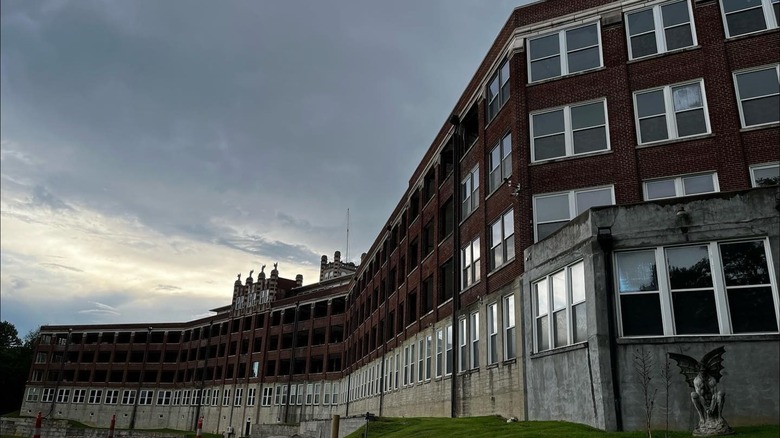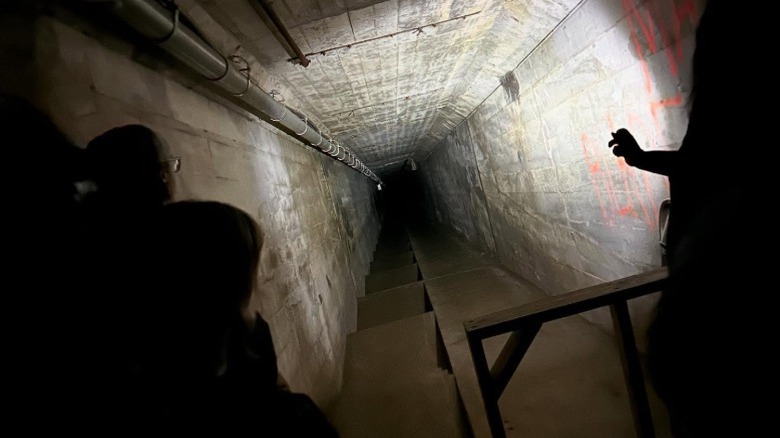Kentucky's Most Haunted Destination Is A Horrifying Hospital With Ghost Tours And Overnight Stays
Fade in, exterior — day: Five sprawling stories of arresting Tudor Gothic brick and ornate stonework unfurl across 180,000 square feet, capped by a distinctive tower with buttresses standing sentry above a three-bay arched (unwelcoming) entrance. Rows of windows line the unflinching facade, glaring down from one of Jefferson County, Kentucky's highest hills, shrouded in woodland and foreboding. A gargoyle awaits. Interior — night: Skeletal remains of wards, walls reveal peeling paint and graffiti; in the dimness you might glimpse chimerical forms scampering by. Deathly silence, except for children laughing and running footsteps. Morose murmurs of outside light discombobulated through broken panes (is that a face?) into spectral shadows on floors splayed with morbid mementoes of lives lost. Weeds unwieldy; the hallways stretch into murky nothingness — the kind where you roll a ball and it glides back to you, though no one is visible at the far end. Fade to black.
It's the perfect setting for a horror movie – except there's nothing cinematic about this horrifying hospital. Abandoned yet alive with supernatural energy, the former Waverly Hills Sanatorium is considered one of the world's most haunted destinations, overflowing with spooky stories, sensations, and strange encounters from operating rooms and wards to kitchens and solaria. It's also a magnet for paranormal investigators and has appeared on TV shows such as "Ghost Hunters," "Ghost Adventures," and "Destination Fear." For the rest of us, there are overnight stays guided by experienced investigators with ghost-hunting equipment. If a disquieting dusk-to-dawn is not your definition of dare, tread more lightly with ghost tours that pack in all five sprawling levels in two twilight hours. You'll have to experience it to believe that this incurable darkness actually lurks in Louisville, one of America's friendliest cities and charming foodie mecca.
The Waverly Hills Sanatorium checked in tuberculosis patients who never left
In the early 1900s, Waverly Hills opened to treat people suffering from a relentless "White Plague" — tuberculosis — which was ravaging Jefferson County at a rate among the highest in the United States at the time. To stem infection, the sanatorium functioned as a self-contained community, with farming, butchery, and other daily operations. At its height, it is believed to have housed more than 1,000 stricken patients. By 1961, advances in antibiotics made such facilities largely obsolete, and the hospital closed. For nearly half a century afterward, the unused complex fell into disrepair and became prey to vandals.
In a Frankensteinian twist, some Waverly doctors experimented with unorthodox "cures" like collapsing infected lungs, removing parts of the lungs and ribs, and electroshock therapy. The resulting mortality rate was severe enough that a motorized "body chute" was built to secretly shuttle corpses downhill to waiting hearses. Today, that steep descent is a popular stop on the tour. On the fourth floor, the atmosphere is said to swell with ominous dread — visitors report being locked in rooms, lights turning on without electricity, and doors slamming shut. But local lore fixates on Room 502, a bathroom where legends say two nurses died by suicide and where unexplained touches, sounds, orbs, mists, and sudden temperature drops commonly occur.
On a lighter note, two-hour daytime historical tours showcase the sanatorium's architectural significance and tuberculosis history, anchored by its National Register of Historic Places designation. Each fall, the complex transforms into a rip-roaring haunted house for Halloween fun. If you want more uncanny Kentucky chills, head east of Louisville to haunted railroad trestles draped in eerie legend – or explore the Mammoth Cave system and its Heritage Trail, one of the scariest national park hikes known to be haunted.

